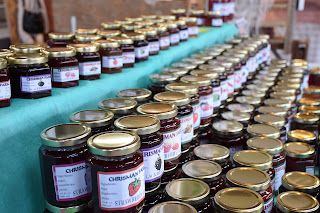WSDA Regional Markets Program
When a farmer who runs a small or mid-scale operation wants to sell a value added-product locally— whether it’s berries frozen during peak season, sliced and bagged carrots, milled or malted grains, or simply fresh produce packed for wholesale—they face a unique challenge: accessing food supply chain infrastructure that’s right-scaled for them.
To move their products to market, farms and local food producers need licensed food processing spaces, processing equipment, storage (including cold, dry, frozen, and refrigerated), transportation (especially refrigerated), and other infrastructure. The problem: most of the infrastructure currently in place is scaled for large quantities of product destined for national and international markets, making it unusable for small and mid-scale farming operations.
 |
| Jarred products. |
For these reasons, WSDA is preparing to award Local Food System Infrastructure and Market Access Grants in the coming year. The grant program’s purpose is to improve food supply chain infrastructure and market access for farms, food processors, and food distributors, with an emphasis on women, minority, and small business owners.
Washington’s current food processing infrastructure
The processing and supply chain infrastructure needed to make farm products locally available depends on the specific product and the buyer’s needs. Farmers may need to jar preserves to retail at a farmers’ market or specialty food store. A farm may need individual quick freeze (IQF) equipment to freeze fruits and vegetables for school districts and other institutions to use during the winter months, when they need frozen produce most. Processors need equipment to mill or malt grains, package them, and sell to grocery stores, bakeries, brewers, and distillers. Farms may need upgraded on-farm infrastructure to wash, pack, and deliver produce to food banks or restaurant and food service kitchens. And the list goes on.
 |
| Packaged carrots. |
Many buyers, especially institutions such school districts, hospitals, or corporate food service accounts, typically purchase minimally processed foods—foods that are cleaned, cut, and ready to use. Lacking the infrastructure to create these products is a significant barrier to expansion for small farms.
For the past four decades our food system trended towards consolidation of food processing, storage, and transportation to make them efficient on a grander scale. Though highly efficient, these systems are inaccessible to smaller operations. The trend has led to lack of investment in regionally scaled infrastructure, including the near-disappearance of co-packers that help small farms develop and process value-added products. Making this infrastructure obtainable is essential to closing the local supply chain loop.
Small-Scale Food Infrastructure in Action
Some farms and food hubs have developed innovative approaches, working together to help fill the gap. Cloud Mountain Farm Center, which is located near Bellingham and serves as an aggregation center for farms in the area, invested in cold food processing equipment and a WSDA-certified processing room more than five years ago.
Director Elizabeth Hayes says the setup allows small farms to expand into minimally processed cold foods. Currently, three farms regularly use the equipment and another three to five farms use it for special projects each season. Products include cut greens, sliced and bagged carrot coins, kimchi, salsa, and other goods. One farm hosts a dehydrator in the space to dry alliums and Basqe peppers. Farms can also rent cold storage space for their goods.
LINC Malt, a project of LINC Foods, a worker- and farmer-owned food hub based in Spokane, provides small grain producers in the Inland Northwest with malting services to transform their grains into a regionally unique product they can sell to brewers and distillers. Malting is a complex process that involves soaking grains, allowing them to germinate, then drying and toasting them at just the right time. Because the expense and expertise required to run such an operation are far beyond the scope of most growers, this operation opens up markets that would otherwise remain closed to many of Washington’s grain producers.
Brian Estes, partnership director, says LINC’s malting operation produces between 300 and 330 tons of finished malt for six to eight regional growers each year. Since they started the operation in 2016, they have worked with 60-70 brewers and distillers, primarily located in Washington and Oregon.
These are just two examples of the ways that investments in infrastructure and collaborative approaches create opportunities for individual farms and food businesses and benefit the local food economy.Infrastructure and Market Access Grants
The cost of developing these systems is far too high for an individual small farm to shoulder alone. But with the help of grants, such as forthcoming WSDA Local Food Infrastructure, Supply Chain, and Market Access Grants, farmers and farming communities can put systems in place that make sense for small and mid-scale farms across Washington State.
These infrastructure grants are possible because the legislature allocated a total of $17 million to strengthen Washington’s food system and develop small businesses. The grants will include two funds:
- $8 million for local food system infrastructure and market access grants, prioritized for women, minority, and small business owners.
- $9 million to improve food supply chain infrastructure and market access for farms, food processors, and food distributors.
WSDA is pleased to support food infrastructure and access projects through these awards. Right now, WSDA Regional Markets Program is gathering input via the Input Survey: WSDA Local Food Infrastructure, Supply Chain and Market Access Grants. Please take the survey and help shape the design of these important grants.

